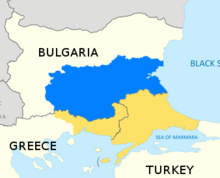
Northern Thrace or North Thrace (Bulgarian: Северна Тракия, Severna Trakiya; Turkish: Kuzey Trakya; Greek: Βόρεια Θράκη), also called Bulgarian Thrace, constitutes the northern and largest part of the historical region of Thrace. It is located in Southern Bulgaria and includes the territory south of the Balkan Mountains and east of the Mesta River, bordering Western Thrace and East Thrace in the south, and the Black Sea in the east. It encompasses Sredna Gora, the Upper Thracian Plain, and 90% of the Rhodopes.
The climate ranges from subtropical to transitional continental and mountainous. The highest temperature recorded in Bulgaria occurred here: it was 45.2 °C (113.4 °F; 318.3 K) at Sadovo in 1916. The main rivers of the region are the Maritsa and its tributaries. Notable cities include Plovdiv, Burgas, Stara Zagora, Sliven, Haskovo, Yambol, Pazardzhik, Asenovgrad, Kardzhali, Dimitrovgrad, Kazanlak and Smolyan. Northern Thrace has an area of 42,073 km2.
The Ottoman Empire created the autonomous province of Eastern Rumelia in Northern Thrace in 1878. The region was annexed by the Principality of Bulgaria in 1885.[1]
YouTube Encyclopedic
-
1/3Views:97055714 336
-
I was orphaned from a young age – Thracian Greek Collection
-
When the ginger girls leave the dance – Thracian Greek Collection
-
Lysimachus, killed in action in 281 BCE
Transcription
Demographics
The ethnic composition of the population of Eastern Rumelia.
| Ethnic group | census 1880 | census 1884 | ||
|---|---|---|---|---|
| Number | % | Number | % | |
| Bulgarians | 573,560 | 70.3% | 681,734 | 70.0% |
| Turks | 174,700 | 21.4% | 200,489 | 20.6% |
| Greeks | 42,456 | 5.2% | 53,028 | 5.4% |
| Roma (Gypsies) | 19,149 | 2.3% | 27,190 | 2.8% |
| Jews | 4,177 | 0.5% | 6,982 | 0.7% |
| Armenians | 1,306 | 0.1% | 1,865 | 0.2% |
| Total | 815,951 | 975,030 | ||
The population's ethnic composition in the Bulgarian provinces of Burgas, Haskovo, Kardzhali, Pazardzhik, Plovdiv, Sliven, Smolyan, Stara Zagora and Yambol.
| Ethnic group | census 2001 | census 2011 | ||
|---|---|---|---|---|
| Number | % | Number | % | |
| Bulgarians | 2,247,532 | 80.94% | 1,856,647 | 72.91% |
| Turks | 315,858 | 11.37% | 258,757 | 10.16% |
| Roma (Gypsies) | 155,954 | 5.62% | 141,538 | 5.56% |
| Russians | 5,185 | 0.19% | 16,538 | 0.65% |
| Armenians | 5,163 | 0.19% | ||
| Greeks | 1,432 | 0.05% | ||
| Jews | 253 | 0.01% | ||
| Others | 8,473 | 0.31% | ||
| Undeclared | 36,958 | 1.33% | 273,151 | 10.73% |
| Total | 2,776,808 | 2,546,631 | ||
See also
References
42°15′00″N 26°00′00″E / 42.2500°N 26.0000°E
